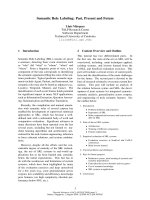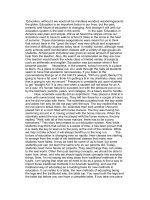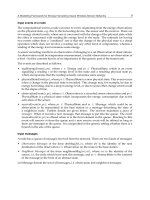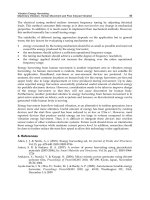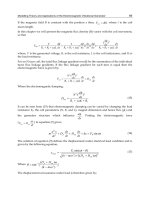Layered Double Hydroxides: Present and Future :Lớp đôi hydroxit: Hiện tại và tương lai
Bạn đang xem bản rút gọn của tài liệu. Xem và tải ngay bản đầy đủ của tài liệu tại đây (13.04 MB, 513 trang )
LAYERED DOUBLE HYDROXIDES:
PRESENT AND FUTURE
No part of this digital document may be reproduced, stored in a retrieval system or transmitted in any form or
by any means. The publisher has taken reasonable care in the preparation of this digital document, but makes no
expressed or implied warranty of any kind and assumes no responsibility for any errors or omissions. No
liability is assumed for incidental or consequential damages in connection with or arising out of information
contained herein. This digital document is sold with the clear understanding that the publisher is not engaged in
rendering legal, medical or any other professional services.
LAYERED DOUBLE HYDROXIDES:
PRESENT AND FUTURE
VICENTE RIVES
E
DITOR
Nova Science Publishers, Inc.
New York
Copyright © 2001 by Nova Science Publishers, Inc.
All rights reserved. No part of this book may be reproduced, stored in a retrieval system or
transmitted in any form or by any means: electronic, electrostatic, magnetic, tape, mechanical
photocopying, recording or otherwise without the written permission of the Publisher.
For permission to use material from this book please contact us:
Telephone 631-231-7269; Fax 631-231-8175
Web Site:
NOTICE TO THE READER
The Publisher has taken reasonable care in the preparation of this book, but makes no expressed
or implied warranty of any kind and assumes no responsibility for any errors or omissions. No
liability is assumed for incidental or consequential damages in connection with or arising out of
information contained in this book. The Publisher shall not be liable for any special,
consequential, or exemplary damages resulting, in whole or in part, from the readers’ use of, or
reliance upon, this material.
This publication is designed to provide accurate and authoritative information with regard to
the subject matter covered herein. It is sold with the clear understanding that the Publisher is
not engaged in rendering legal or any other professional services. If legal or any other expert
assistance is required, the services of a competent person should be sought. FROM A
DECLARATION OF PARTICIPANTS JOINTLY ADOPTED BY A COMMITTEE OF THE
AMERICAN BAR ASSOCIATION AND A COMMITTEE OF PUBLISHERS.
LIBRARY OF CONGRESS CATALOGING-IN-PUBLICATION DATA
Available upon request.
ISBN 978-1-61209-289-8 (eBook)
Published by Nova Science Publishers, Inc. New York
CONTENTS
Preface vii
Part I: Synthesis, Structure and Characterisation
Chapter 1 Layered Double Hydroxides: Synthesis and Post-Synthesis Modification 1
A. de Roy, C. Forano and J. P. Besse
Chapter 2 Crystal Structure and X-ray Identification of Layered Double Hydroxides 41
V. A. Drits and A. S. Bookin
Chapter 3 Computer Modelling of Layered
Double Hydroxides 101
S. P. Newman, H. C. Greenwell, P. V. Coveney and W. Jones
Chapter 4 Study of Layered Double Hydroxides by Thermal Methods 127
Vicente Rives
Chapter 5 Infrared and Raman Spectroscopic Studies of Layered Double
Hydroxides (LDHs) 153
J. T. Kloprogge and R. L. Frost
Chapter 6 Solid-State NMR and EPR
Studies of Hydrotalcities 217
João Rocha
Chapter 7 Investigating Layered Double Hydroxides by Mössbauer Spectroscopy 241
Chr. Bender Koch
Chapter 8 Surface Texture and Electron Mincroscopy Studies of Layered
Double Hydroxides 257
Vicente Rives
Part II: Applications
Chapter 9 Layered Double Hydroxides in
Water Decontamination 285
María Ángeles Ulibarri and María del Carmen Hermosín
Chapter 10 Applications of Hydrotalcite-Type Anionic Clays
(Layered Double Hydroxides)
in Catalysis 323
Francesco Basile and Angelo Vaccari
Chapter 11 Hydrogenation Catalysis by Mixed Oxides Prepared from LDHs 367
A. Monzón, E. Romeo and A. J. Marchi
Chapter 12 Layered Double Hydroxides and their Intercalation Compounds in
Photo-chemistry and in Medicinal Chemistry 435
Umberto Costantino and Morena Nocchetti
Chapter 13 Environmental Chemistry of Iron(II)-Iron(III) LDHs
(Green Rusts) 469
Hans Christian Bruun Hansen
Index 495
PREFACE
Layered Double Hydroxides (LDH), hydrotalcite-like (HTl), hydrotalcite-type (HTt),
anionic clays, , are the commonest names applied to a wide family of layered materials,
despite none of these names fully corresponds to the actual situation. Also known in some
occasions as layered hydroxycarbonates, whichever the name given, these materials are not so
extended in nature as the well known cationic clays, but are very easy to prepare and they are
not generally expensive.
The first natural mineral belonging to this family of materials was discovered in Sweden in
1842, is known as hydrotalcite, and was given the general formula Mg
6
Al
2
(OH)
16
CO
3
·4H
2
O.
The first studies on the synthesis, stability, solubility and structure determination date back to
1930 and were mostly carried out by Feitknecht [1,2].
Essentially, the structure can be described as a cadmium iodide-type layered hydroxide
(e.g., Mg(OH)
2
, brucite) where a partial Mg
2+
/Al
3+
substitution has taken place (thus the name
“layered double hydroxide”), balancing of the electric charge being achieved by location of
anions in the interlayer space (carbonate in most of the samples found in nature, so the name
“layered hydroxycarbonates”), where they co-exist with water molecules. Nowadays, solids
with this structure, but containing more than two different (a divalent and a trivalent one)
cations in the brucite-like layers, are also known.
What makes interesting to these materials is the fact that the nature of the layer cations can
be changed among a wide possible selection (almost exclusively restricted by size and charge),
and the nature of the interlayer anion can be also (almost freely) selected, among organic or
inorganic, simple or complex anions, polyoxometalates, simple anionic coordination
compounds, etc. An additional feature that makes them similar to cationic clays is the fact that
they can be also pillared, although doubts still exist in the literature about the thermal stability
of the structures formed. Also as cationic clays, the interlayer species can be rather easily
exchanged, thus increasing their applications and opening new synthetic routes to prepare
derivatives.
A unique property these solids exhibit, so making them different from cationic clays, is that
after thermal decomposition under mild conditions, they are able to recover the layered
structure, this property representing, again, a new synthetic route for analogues.
The possibilities all these properties open are surprisingly wide, and so the applications of
these materials are widening almost every day. The principal areas of interest include their use
as catalysts and catalyst supports, adsorbents, anion scavengers, anion exchangers, polymer
stabilizers, antacids, antipeptins and stabilizers. The restricted interlayer space also represents a
Vicente Rives viii
sort of “nanoreactor” to perform chemical reactions in a constrained region, which may even
modify well known properties of molecules (e.g., photochemical properties).
In recent years several reviews have appeared on these LDHs, dealing with their general
chemistry and properties [3], structure and pillared derivatives [4], analogues with interlayer
organic anions [5] or with intercalated anionic coordination compounds or oxometalates [6]
with different nuclearity degree. With respect to their applications, Cavani, Trifirò and Vaccari
published some years ago a very outstanding review [7] which has somewhat become a guide
to learn about the catalytic properties of these solids and their derivatives. A general
comparison of cationic and anionic clays has been also reported [8]. Also, special issues of one
of the leading journals on clays have been devoted to different properties of these fascinating
materials [9-11], and special sessions dealt to these materials in regional and world-wide
international conferences.
Some of these reviews are rather recent, and so we have intended to avoid any sort of
repetition or overlapping with their content, unless the scientific production in its particular
area has provided a large number of papers, worthwhile to be reviewed and summarised.
Most of these studies have insisted or are dedicated to particular areas of interest of LDHs,
i. e., synthesis, structure, particular applications, etc. However, the aim of this book is to present,
in an unified form, an updating of current knowledge about LDHs, from different points of view,
i. e., paying attention to their synthesis, their properties and, finally, their applications. We have
chosen a rather “academic” way to cope with this subject, and we have tried to present the
current knowledge about their structures and properties giving an account on the sort of
information which may be known from application of specific, but well known and easily
available, characterisation techniques. Altogether, we hope this represents an updated and
comprehensive description of LDHS from almost every point of view.
So, the first section comprises a total of eight chapters devoted to the synthesis and
physicochemical characterisation of these materials. Besse and his coworkers describe the
structure of these compounds in relation to their synthesis, their preparative methods, and also
providing a developing strategy for post synthesis modification.
Drits and Bookin perform a detailed study on the structural features of LDHs, namely, the
isomorphous substitutions in the brucite-like layers, regularities in anion locations,
order-disorder phenomena in the layers and in the interlayer, different LDH polytypes, stacking
faults, etc.
Jones and his coworkers report computer simulations to probe the interlayer structure and
dynamics of LDHs, due to the lack of detailed structural information available for these
materials, especially when containing organic interlayer anions.
One of the outstanding properties of LDHs is their ability to recover their layered structure
even after being calcined at moderate temperatures. The effect of using different atmosphere
conditions during decomposition, discriminating steps associated to dehydration,
dehydroxylation, structure collapsing and formation of crystalline phases, as well as the effect
of the nature of the interlayer anion on the final solids, are the aim of the following chapter.
Spectroscopic techniques have been also applied to characterise LDHs. The main results
reported in the literature on these solids, obtained by application of vibrational spectroscopic
techniques (Infrared and Raman) are reviewed by Kloprogge and Frost, and Rocha reports on
the application of solid state resonance techniques (mainly MAS-NMR, but also, although in a
lesser extent, EPR) to characterize the solids in order to obtain a complete description of these
systems, for different spectroscopically active nuclei studied so far.
Preface ix
Koch reports the application of Mössbauer spectroscopy to the characterization of LDHs;
although virtually restricted to LDHs containing iron, this may be present both in the
brucite-like layers, or forming anionic complexes in the interlayers, so deserving the
application of specific techniques for its study.
This section of the book ends with a chapter by Rives dedicated to the study of the surface
texture and morphology of these solids, as concluded by electron microscopies; bearing in
mind the usefulness of LDHs as catalyst precursors, it is necessary to have a precise description
of its surface texture, and its evolution along the thermal treatments applied to obtain the final
catalysts.
Obviously, some other experimental techniques could be summarized and included in
additional chapters, but the “knowledge” corpus from other techniques is rather scarce in these
moments.
The second section of the book deals with the applications of LDHs. Again, the expertise
reader with a deep knowledge of the LDHs literature may feel some applications are lacking,
but we have again tried to include those applications for which a systematic and rather
pedagogic analysis can be carried out.
So, the first chapter in this section is dedicated by Ulibarri and Hermosín to the study of the
application of LDHs and calcined LDHs to decontamination processes, mostly making us of
two important features: the ability of LDHs to exchange their interlayer anions, and the ability
of calcined LDHs of recovering the layered structure when put in contact with solutions of
anions.
Then, two chapters by Vaccari and Basile, and by Monzón and coworkers, deal with the
catalytic applications of LDHs and calcined LDHs; although these applications have been the
aim of reviews published in the last decade, the increasing number of papers in the literature on
this subject makes worthwhile to include an account of this (probably the most outstanding)
application of LDHs. Emphasis is made on present and potential applications, related to the
wide number of composition and preparation variables, as well as on upgrading from 2- to
3-dimensions by pillaring and/or intercalation processes.
Costantino and coworkers provide a chapter which includes two types of applications:
photochemical properties/applications, from the ability of LDHs to organize photoactive
species in the interlayer and/or on the surface of the microcrystals, with applications in
non-linear optics, energy storage and conversion. Applications of LDHs in Medicine are also
reviewed; this is still a rather unexplored area, but we should not forget that some of very
common drugs contain hydrotalcite in their formulation.
Finally, Hansen reports a detailed study of a material known as “green rust”, an LDH
containing Fe(II) and Fe(III), which usually occur as transient phases on corrosion of iron, and
plays an plays an important role in transitions between anoxic and oxic soils conditions, and
overall may help to understand the role of iron in Nature.
Promising applications appear every day in the literature, and probably unforeseen
applications will turn up shortly. Their versatility, wide range of composition and very
especially their low cost will probably favour in the near future an extended and widened
interest in Layered Double Hydroxides.
Vicente Rives x
Last, but not the least, it has been a pleasure for me to act as Editor of this multi-author
book. I apologize for the subjects not included, and for the potential authors who were not
invited to participate; this was only my exclusive fault. But the undoubted success of the book
will be a shared one with a bunch of excellent scientists, but, overall, good friends.
Thank you.
REFERENCES
[1] W. Feitknecht and G. Fischer, Helv. Chim. Acta 18 (1935) 555.
[2] W. Feitknecht, Helv. Chim. Acta 25 (1942) 131.
[3] F. Trifirò and A. Vaccari, in Comprehensive Supramolecular Chemistry (Eds. J. L.
Atwood, J. E. D. Davies, D. D. MacNicol, F. Vögtle, J M. Lehn, G. Albert, T. Bein),
Pergamon, Oxford, vol. 7 (1996) pp. 251-291.
[4] A. De Roy, C. Forano, K. El Malki, J P. Besse, in Synthesis of Microporous Materials
(Eds. M. L. Occelli and H. E. Robson), Van Nostrand Reinhold, New York, vol. 2
(1992) pp. 108-169.
[5] S. P. Newman and W. Jones, New J. Chem. (1998) 105.
[6] V. Rives and M. A. Ulibarri, Coord. Chem. Rev. 181 (1999) 61.
[7] F. Cavani, F. Trifirò and A. Vaccari, Catal. Today 11 (1991) 173.
[8] A. Vaccari, Appl. Clay Sci. 14 (1999) 161.
[9] A. Vaccari (guest editor), Appl. Clay Sci. 10 (1995) pp. 1-186.
[10] D. Tichit and A. Vaccari (guest editors), Appl. Clay Sci. 13 (1998) pp. 311-511.
[11] F. Basile, M. Campanati, E. Serwicka and A. Vaccari (guest editors), Appl. Clay Sci.
18 (2001) pp. 1-110.
PART I: SYNTHESIS, STRUCTURE
AND CHARACTERISATION
In: Layered Double Hydroxides: Present and Future ISBN: 1-59033-060-9
Editor: Vicente Rives, pp. 1-39 © 2006 Nova Science Publishers, Inc.
Chapter 1
LAYERED DOUBLE HYDROXIDES: SYNTHESIS AND
POST-SYNTHESIS MODIFICATION
A. de Roy, C. Forano and J. P. Besse*
Laboratoire des Matériaux Inorganiques
Université Blaise Pascal (Clermont-Fd) – UMR 6002
F-63177 AUBIERE CEDEX, FRANCE
*E-mail :
INTRODUCTION
The term of Lamellar Double Hydroxides (LDHs)
1
is used to designate synthetic or natural
lamellar hydroxides with two kinds of metallic cations in the main layers and interlayer
domains containing anionic species. This wide family of compounds is also referred to as
anionic clays, by comparison with the more usual cationic clays whose interlamellar domains
contain cationic species. LDHs are also reported as hydrotalcite-like compounds by reference
to one of the polytypes of the corresponding [Mg-Al] based mineral. More seldom are they
named pyroaurite-like compounds, lamellar hydroxides of transition metals, mixed metallic
hydroxides, double layer hydroxides, or hybrid layer structures.
Such minerals are reported since the beginning of this century
2
and the preparation of
synthetic phases is generally based on the controlled precipitation of aqueous solutions
containing the metallic cations and began with the early work of Feitknecht.
3
Since the end of the sixties, an increasing interest is being given to LDHs in the fields of
structural characterisation, preparation of new compounds and new preparative methods,
anionic exchange properties, electrochemical and magnetic properties, heterogeneous catalysis,
pharmaceutical applications, etc. Several review papers and references therein give current
trends on this subject.
4-6
The aim of this paper is to picture a general overview on LDHs, but we shall mainly point
out some particular features about the structure of these compounds (in relation to their
synthesis), their preparative methods and give a tentative development strategy for post
synthesis modification illustrated by some examples.
A. de Roy, C. Forano and J.P. Besse 2
STRUCTURAL DESCRIPTION
The LDH structure is based on M(OH)
6
octahedral units sharing edges in order to build
M(OH)
2
brucite-like layers. These octahedral units contain both divalent and trivalent metallic
cations ; the main layers are therefore positively charged, and the charge density is proportional
to the trivalent metal ratio x = M
III
/(M
II
+M
III
). The whole structure is constituted by the
stacking of such layers, intercalating charge-balancing anionic species and water molecules as
shown in Figure 1, where the heavy general chemical formula, shortened as [M
II
-M
III
-X] is also
given.
Figure 1 Schematic view of the LDH structure and general formula. Reprinted from A. de Roy, C. Forano, K.
El Malki and J.P. Besse, Anionic Clays: Trends in Pillaring Chemistry, in Expanded Clays and Other
Microporous Solids, edited by M.L. Occelli and H.E. Robson (Van Nostrand Reinhold, New York 1992), vol. II,
Chap. 7 pp. 108-169, reproduced with permission from the authors.
LDHs exhibit a high charge density on the main layers. For example, a x = 1/3 trivalent
metal ratio corresponds to one charge for 50 Å
2
on each side of the layer, leading to one charge
for 25 Å
2
in the interlamellar domains.
Trivalent metal ratio
Most of LDH systems accommodate a relatively wide range of trivalent ratios, but it is not
reported that it could vary from 0 to 1 without main structural changes. While larger ranges are
sometimes given, the most reliable limits, are based for example on a clear evolution of lattice
parameters and correspond approximately to 0.2 ≤ x ≤ 0.4 (Figure 2). Some authors describe
Layered Double Hydroxydes: Synthesis and Post-Synthesis Modification 3
systematically LDHs by the divalent versus trivalent ratio R = M
II
/M
III
, generally with an
integer value (for example, R = 2, R = 3), corresponding to the relative proportions of metallic
cations in the reactants during the preparation. In all cases, it is not obvious that a pure LDH
phase is always obtained, while the global composition of the precipitate corresponds to the
expected value, but contains secondary phases such as hydroxides or basic salts of the divalent
or trivalent metal.
Figure 2 Comparison of trivalent metal ratio x scale and divalent vs. Trivalent R scale, and divalent vs.
trivalent R scale, and corresponding limits for LDH compositions.
The upper limit of trivalent ratio is generally attributed to electrostatic repulsion between
neighbouring trivalent metals in the layers, which is unavoidable if x > 1/3, and also to
repulsion between the charge-balancing anionic interlamellar species. The lower limit could
correspond to a too high main distance between these interlamellar anions leading to a collapse
of the interlamellar domains. The structure of the
α
-variety of divalent metals hydroxides with
neutral M(OH)
2
sheets and interlamellar domains containing salts or basic salts and water
molecules seems to be close to a LDH structure with x = 0, but, as far as we know, compared to
regular LDH structures there is a solution of continuity in the values of x.
The metallic cations are arranged in the layers on an hexagonal framework of parameter a
0
.
For particular values of x, superstructures can be expected by ordering of divalent and trivalent
cations. In hexagonal symmetry, the solutions are given by the relation 1/x = (a/a
0
)
2
, where a is
any metal-metal distance in the hexagonal framework. The first solutions are x = 1/3, 1/4, 1/7,
1/9, 1/12, 1/13, … The survey of experimental data show that the existence of such
superstructures seems clearly evidenced only in a few cases. In other cases, the use of a
stoichiometric formula is only a simplified formalization and, in fact, the studied compounds
are essentially nonstoichiometric, with a random distribution of metallic cations in the layers.
On the contrary, a particular value can be systematically observed in some systems, for
example x = 1/3 in [Zn-Cr] based LDHs. Such particular values are also often reported in
minerals, mainly with x = 1/3 and x = 1/4 (Figure 2). These structural properties are discussed
in more detail in another chapter of this book.
Metal cations in the layers
The divalent and trivalent metal cations found in LDHs belong mainly to the third and
fourth periods of the periodic classification of the elements :
- divalent cations: Mg, Mn, Fe, Co, Ni, Cu, Zn,
- trivalent cations: Al, Mn, Fe, Co, Ni, Cr, Ga.
A. de Roy, C. Forano and J.P. Besse 4
The ionic radii are in the range 0.65 - 0.80 Å for divalent cations and 0.62 - 0.69 Å for
trivalent ones (with the main exception, Al : 0.50 Å).
Higher ionic radii (Ca, Cd and Sc, La) seem to be incompatible with the formation of true
brucite-like layers. LDHs can also be obtained with a Li-Al monovalent-trivalent and Co-Ti
divalent-tetravalent associations or with more than two different cations in the layers; this is
also generally observed in LDH minerals containing variable amounts of minor elements.
Structure of the layers
In LDHs, the octahedral environment of metallic cations is far from being a regular
polyhedron. The octahedra are strongly flattened along the stacking direction, lowering the
symmetry from O
h
to D
3d
, as illustrated in Figure 3 for a [Zn-Al] based LDH. The higher is the
mean metal ionic radius, the more flattened are the octahedra with a lowering of the layer
thickness h and an increase of the distance a between metals – which is the same as between
OH groups on same side of the layer.
Figure 3 Flattening of the M(OH)6 octahedron in a [Zn-Al] LDH.
This evolution is illustrated in Table 1 with results from X-ray Rietveld structure
refinement, for two [Zn-Al] and [Zn-Cr] based LDHs. The comparison of calculated and
observed M-OH distances show that a simple geometrical model based on ionic radii is unable
to provide quantitative predictions. It also appears clearly that the hydoxyl groups on each side
of the main layer do not build a really close-packing layout with such high OH-OH distances (≈
3.1 Å).
If the radius of one of the metallic cations becomes too high, the octahedral coordination is
lost by opening of one side of the octahedron on the interlamellar domain leading to additional
coordination with one interlamellar water molecule. The symmetry around the metal is lowered
from D
3d
to C
3v
. Such a behaviour is observed in minerals from the hydrocalumite group. For
[Ca-Al] based layers, three different short range distances are observed around calcium: 3
Ca-OH at 2.375 Å, 3 Ca-OH at 2.455 Å, and 1 Ca-OH
2
at 2.497 Å.
Layered Double Hydroxydes: Synthesis and Post-Synthesis Modification 5
Table 1 Structural data about the layers of two [Zn-Al] and [Zn-Cr] based LDHs ;
distances are in Å and angles in degrees.
composition of main layers Zn
3/4
Al
1/4
(OH)
2
Zn
2/3
Cr
1/3
(OH)
2
mean M
II
-M
III
ionic radius 0.68 0.72
M-OH distance (calc. / obs.) 2.04 / 2.053 2.08 / 2.053
a (mean M-M distance) 3.083 3.120
h (along C
3
axis) 2.071 2.020
OH-OH distance (same / alter. side)3.083 / 2.729 3.120 / 2.707
OH-M-OH angle (same / alter. side)96.9 / 83.0 98.1 / 81.9
Interlamellar anions
In LDHs, the interlamellar domains contain anions, water molecules and sometimes other
neutral or charged moieties. One major characteristic of LDHs is that, in most cases, only weak
bondings occur between these interlamellar ions or molecules and the host structure. A great
variety of anionic species can therefore be located between the layers during the formation of
the lamellar structure, or by further anionic exchange.
These anions can be:
- halides : fluoride, chloride,…
- oxo-anions : carbonate, nitrate, sulphate, bromate, …
- oxo and polyoxo-metallates : chromate, dichromate, (Mo
7
O
24
)
6-
, (V
10
O
28
)
6-
, …
- anionic complexes : ferro and ferricyanide, (PdCl
4
)
2-
, …
- organic anions : carboxylates, phosphonates, alkyl sulphates, …
In relation to the size, charge and layout of these interlamellar species, the basal spacing of
the layers is dramatically modified as shown in Figure 4, which gives a selection of inorganic
and organic species. The most remarkable features are:
− the large gap between brucite and the smallest basal spacings in LDHs, corresponding to
the intercalation of an interlamellar monolayer,
− the small distance range for a series of small anions - hydroxyl, fluoride, carbonate,
chloride, attributed to a “levelling” effect of water molecules,
− he clear separation between inorganic anions intercalated LDHs with basal spacings lower
than 15 Å, even for species such as the decavanadate, and hybrid LDHs intercalating
organic anions and displaying distances larger than 15 Å.
A. de Roy, C. Forano and J.P. Besse 6
Interlamellar structure
The structure of interlamellar domains is more difficult to characterize than the main layers.
With small anionic species, such as halides and carbonates, and up to sulphate-containing
LDHs with a basal spacing of 11Å, a regular stacking of the layers is observed in the X-ray
diffractograms. With bulky anions, the stacking of the layers displays in most cases no more
long-range ordering (turbostratic effect) and the diffractograms show only lines relative to the
basal spacing and to the structure of the main layers.
As an example, we give here the results of X-ray Rietveld structure refinement on a
[Zn-Cr-Cl] LDH (Table 2). The same R-3m space group was used for the first structural
resolution on a monocrystalline LDH mineral.
7
This space group is very “low cost” with only
one refinable atomic position parameter for the main layers, and one more for the interlamellar
domain, where chloride and oxygen of water molecules are randomly distributed on a high
multiplicity position around the C
3
axis. As reported in Figure 5, the hydroxyl groups are facing
one another between two succesive layers and the layout of interlamellar species is in
agreement with hydrogen-bonding onto the main layers.
Figure 4 Evolution of basal spacing with intercalated anions.
Layered Double Hydroxydes: Synthesis and Post-Synthesis Modification 7
Table 2 Rietveld structure refinement of a [Zn-Cr-Cl] LDH.
space group R-3m a = 3.124 Å reliability :R
I
= 4.53 %
3R stacking c = 23.29 Å R
WP
= 13.25 %
atoms site x y z B
11
(Å
2
) B
33
(Å
2
)
2 Zn, 1 Cr 3 (a) 0 0 0 2.4 (2) 5.2 (4)
6 OH 6 (c) 0 0 0.3810 (2) 3.6(2) 4.8(2)
1 Cl, 2 H
2
O 18 (g) 0.269 (3) 0 1/2 15.7 (4) 2.45 (3)
Figure 5 Disposition of interlamellar species in a [Zn-Cr-Cl] LDH.
This 3R rhombohedral stacking is also reported with other interlamellar halides or with
carbonates. For LDHs intercalating anions of tetrahedral shape such as sulphate, the structures
are described in hexagonal space groups (P63/mmc and P63/mcm) leading to a 2H stacking of
the layers.
8
A. de Roy, C. Forano and J.P. Besse 8
A Nomenclature for LDHs
A LDH phase is mainly described by its chemical formula, the basal spacing of the layers
and the symmetry of the stacking sequence. We have shown that the heavy general formula
given in Figure 1 could be shortened as [M
II
-M
III
-X]. We propose now an extended symbolic
notation
n
x
[M
II
-M
III
-X]
d
ss
constituted of three parts :
- the qualitative chemical data between brackets, with divalent-trivalent anion symbols, in
this order and separated by hyphens,
- on the left side, quantitative chemical data: trivalent metal ratio x and hydration state n
based on a M(OH)
2
formula,
- on the right side, structural data: basal spacing d of the layers in Å and their stacking
sequence ss (3R, 2H, …).
A great adaptability can be expected from this notation by the use of all or part of the full
symbol, for example in a
0.33
[Zn-Cr-Cl] phase, the [Zn-Cr] symbol refers to the framework
regardless to the nature of the interlamellar anion.
4
PREPARATION OF LDHS
LDHs exist as minerals with names depending on their composition and the symmetry of
polytypes
9
for example :
- Hydrotalcite, Manasseite Mg, Al
- Sjögrenite, Pyroaurite, Coalingite Mg, Fe
- Stichtite, Babertonite Mg, Cr
- Takovite Ni, Al or Ni, Ni
- Reevesite Ni, Fe
- Woodwardite Cu, Al
where the interlamellar anion is mainly carbonate, and sometimes sulphate or chloride.
Their composition is generally complex with minor elements and associated phases; it is
therefore necessary to prepare synthetic phases for an extensive study of LDHs.
Coprecipitation Method
This is the most common preparative method of LDHs. It is based on the slow addition of a
mixed solution of divalent and trivalent metals salts in adequate proportions into a reactor
containing water. A second solution (alkaline solution) is added in the reactor in order to
maintain the pH at a selected value leading to the coprecipitation of the two metallic salts. A
schematic experimental device is given in Figure 6 - all of the sub-systems are not required for
every experiment.
Layered Double Hydroxydes: Synthesis and Post-Synthesis Modification 9
Mechanism of Coprecipitation
The mechanism of coprecipitation is ideally based on the condensation of hexa-aquo
complexes in solution in order to build the brucite-like layers with a distribution of both
metallic cations and with solvated interlamellar anions. Observation of the precipitates and
X-ray diffraction characterization show that the co-formation of the main layers and
interlamellar domains takes place at a very early stage of the process without clear
“delaminated” state of the layers.
Origin of Interlamellar Anions
The metal cations in the obtained LDH phase are obviously issued from the metallic salts
solution, but the origin of interlamellar anions has to be discussed. If these anions are the
counter-anions of the metallic salts they come from the same solution. If the preparation is
performed at very high pH values, the interlamellar anion can be the hydroxyl anion coming
from the alkaline solution. When the alkaline solution is a sodium or potassium carbonate
solution, the intercalated anion is the carbonate because of its high selectivity for LDHs
interlamellar domains. Moreover, when the preparation is performed at relatively high pHs, one
have to work under CO
2
-free conditions in order to avoid carbonate contamination. Another
way to intercalate a given anion is to prepare a solution of this anion in the reactor prior to the
beginning of the coprecipitation.
So, we see that there is often competition between several anionic species, and the control
of experimental conditions can lead to the selective intercalation of one of them as the primary
interlamellar anion. Secondary interlamellar anions can replace them by further treatments
such as anionic exchange (vide infra).
A. de Roy, C. Forano and J.P. Besse 10
Figure 6 Experimental device for the preparation of LDHs by the coprecipitation method.
Experimental Parameters
Depending on the precipitation conditions, one can generally obtain well crystallized LDH
phases or quasi amorphous materials. Some of these experimental parameters are obvious, like:
- temperature in the reactor,
- pH of the reaction medium,
- concentration of metallic salts solution,
- concentration of alkaline solution,
- flow rate of reactants,
- aging of the precipitate,
other parameters are less obvious, such as :
- accumulation of electrolytes in the reaction medium,
- hydro-dynamics of the dilution of reactive species, related to the stirring mechanism,
geometry of the reactor including reactants injection pipes,
- complexation state of the metallic cations which, depending on the previous history of the
metallic salts solutions, can give rise to a great number of different M(OH
2
)
u
(OH)
v
X
w
charged monomers and also to oligomers.
In order to obtain well organised phases, the operating conditions have to be optimized for
each system. In all cases, synthetic LDHs are obtained as microcrystalline platelets generally
Layered Double Hydroxydes: Synthesis and Post-Synthesis Modification 11
aggregated in a “rose des sables“ morphology as shown by SEM. The low BET surface areas
measured (20-40 m
2
g
-1
) are in good agreement with the external surface of the platelets.
The effect of the precipitation pH on the formation of LDH compounds is well-evidenced
by the investigation realized on [Zn-Al-Cl],
0.33
[Zn-Cr-Cl]
3R
and
0.33
[Cu-Cr-Cl]
3R
systems.
The
0.25
[Zn-Al-Cr]
3R
LDH has been prepared in the pH range from 4.0 to 11.0. For such a
composition, a compound with a well ordered hydrotalcite-like structure forms in the pH range
from 7.0 to 10.0. At lower pH values, an amorphous compound is obtained, while at higher pH
values brucite-type Zn(OH)
2
crystallizes together with the LDH phase. One must notice that,
for such pH values, the reaction of formation of the LDH corresponds to a simultaneous
precipitation of both metallic cations, the pH being greater than the precipitation pH of both
Zn(OH)
2
and Al(OH)
3
.
In the case of the
0.33
[Zn-Cr-Cl]
3R
phase, a pure and well ordered LDH is formed at a pH
much lower than that for [Zn-Al-Cl]
3R
;
0.33
[Zn-Cr-Cl]
3R
is obtained at pH = 4.5-5.0, and badly
crystallized or amorphous materials are obtained at pH values higher than 5.0. An X-ray
diffraction study of LDH prepared from pH = 4.5 to 10 (Figure 7) shows an improvement in the
crystallinity when the pH is lowered. It should be notice that, in this case, the optimal pH of 4.5
is lower than the pH of precipitation of Zn(OH)
2
, and therefore the coprecipitation does not
occur in these conditions. The reaction must probably proceed via the precipitation of Cr(OH)
3
,
and then the reaction of Cr(OH)
3
with Zn
2+
cations in solution. The chemical composition of
the final product diverges from the initial M
2+
and M
3+
ratio.
Figure 7 X-ray powder diffractograms of 0.33[Zn-Cr-Cl]3R prepared at pH=10.0 (a) and pH=4.5 (b).
Reprinted from A. de Roy, C. Forano, K. El Malki and J.P. Besse, Anionic Clays: Trends in Pillaring Chemistry,
in Expanded Clays and Other Microporous Solids, edited by M.L. Occelli and H.E. Robson (Van Nostrand
Reinhold, New York 1992), vol. II, Chap. 7 pp. 108-169, reproduced with permission from the authors.
The effect of the pH upon the formation of
0.33
[Cu-Cr-Cl]
3R
is similar. The best crystallized
phase is obtained at the lowest pH value of 5.5. Below this pH, an additional unidentified phase
appears. It must be noticed that, in some cases, the pH does not have a direct observable effect
on the diffraction pattern. The typical example comes from the
0.33
[Ni-Cr-Cl] phase. This phase


